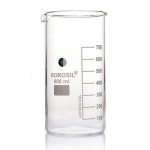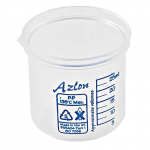- Show results for
- Share
What Is A Beaker & How To Choose One?
Resource Description

Table Of Contents:
- Introduction
- What Is A Beaker And What Is It Used For?
- Beaker Types & Beaker Use
- Choosing A Beaker
- Maintenance & Storage
- Applications
- Final Thoughts
Introduction
Different types of containers are intended for different purposes. In this article, you will find out what a beaker is, and what beaker types there are, we will explain key things to consider when choosing a beaker. In addition, you will know where beakers are used. Ready? Let’s start!
What Is A Beaker And What Is It Used For?
A beaker is typically a glass or plastic container of a cylindrical shape. It can be made of other materials as well. It has a flat bottom and an open top.
What is a beaker used for? What does a beaker do? The purpose of a beaker is to mix, measure, heat, transport liquids, etc. These are beaker purposes. Most beakers have a spout to aid pouring, however, there are models without it. There are various options available and it is important to understand which one is better for your needs.
Beaker Types & Beaker Use
What does a beaker look like? There are different types of beakers. Let’s take a closer look at them.

Depending on the shape, there are:
1. Low-form or Griffin beakers - these are the most common ones. As a rule, they have a height of approximately 1.4 times their diameter. A low-form beaker with a spout was devised by John Joseph Griffin, an English chemist. That’s why this beaker type is called after him. One of the advantages of a Griffin beaker is its versatility. It is used for an array of everyday tasks. Applications: solution preparation, decanting, etc.
2. Tall-form or Berzelius beakers have a height that is approximately twice their diameter. Applications: titration or volumetric analysis, etc.
3. Flat beakers or crystallizers have a larger bottom, which is excellent for a more uniform heating/boiling (for liquids) & a better extraction (for solids). Applications: crystallization, use as a vessel in hot-bath heating, etc.
Choosing A Beaker
There are different aspects to consider if you want to select the beaker.
- Material
What is a beaker made of? Usually, beakers are made of plastic, glass, or stainless steel.

Borosilicate glass beakers are known for their:
- low thermal expansion - they are resistant to temperature changes, strong in thermal shock exposure;
- high material strength - these beakers can withstand blunt force impact well;
- chemical stability - they are perfect if you want your beaker to withstand corrosion & breaking when it is exposed to acidic environments.

Plastic beakers are lightweight and less fragile than glass beakers, for example (if we are talking about regular glass, not borosilicate glass). As there are various plastics, these beakers should be selected depending on the requirements you have (make sure you factor in temperature, chemicals you are going to use, and more).
Here is a table to help you:
Material | Chemical Compatibility | Temperature Range |
Low-Density Polyethylene (LDPE) High-Density Polyethylene (HDPE) | Weak & concentrated acids, bases & alcohol | For LDPE: -148°F to 176°F (-100°C to 80°C) For HDPE: -148°F to 248°F (-100°C to 120°C) |
Polypropylene (PP) | Weak & concentrated acids, bases & alcohol | 32°F to 275°F (0°C to 135°C) |
Polymethylpentene (PMP) | Weak & concentrated acids, bases & alcohol | 68°F to 347°F (20°C to 175°C) |
Polytetrafluoroethylene (PTFE) | Almost all chemicals | -148°F to 500°F (-100°C to 260°C) |

Stainless steel beakers are opaque unlike beakers made of other materials. These beakers are:
- durable;
- shatter-proof;
- impact-resistant.
No matter what material your beaker is made of, always check if it is suitable for your application (if it is compatible with the chemicals you are going to work with and/or if it can withstand the temperatures you need, and so on).
- Temperature
Different materials can be exposed to different temperatures. Note that a beaker can withstand the temperature within a certain range. The information about the temperature should be provided by the manufacturer (you can find it on the beaker, on the package, and/or in the product description).
- Disposable or not?
Decide whether you need a disposable beaker for your task or you are going to use it over and over again. Note that disposable beakers are not recommended for reuse.
- Stackable or non-stackable?
For easy storage, using stackable beakers is a great idea. You can stack such beakers within one another and, as a result, you will save some space, which is very useful.
- Autoclavable or not?
You can’t autoclave any beaker. It should be indicated by the manufacturer that the beaker is autoclavable. For autoclaves, you can wrap the top of your glass beaker with aluminum foil and apply autoclave tape over the foil. If you are going to use labels on the beaker that you want to autoclave, it is recommended to use autoclave-resistant labels.
- With or without a handle
There are beakers with handles that make carrying and pouring liquids easier. For some applications, a beaker without a handle is chosen.
- Jacketed or not?
A jacketed beaker is intended to control the temperature of its contents thanks to an integral jacket through which a temperature-controlling fluid can circulate.
- Heavy-duty or regular?
Heavy-duty beakers have heavier bases, thicker walls, as well as reinforced spouts & rims. Such beakers are less likely to break compared to regular beakers. In addition, they offer extended service life. Heavy-duty beakers are perfect for demanding applications.
- Graduated or not?
There are graduated beakers (that are marked with lines to indicate the volume of the liquid) and non-graduated beakers. Note that graduated beakers won’t help you with the precise measurement of the volume. For this purpose, a graduated cylinder is a better option. A volumetric beaker is used to measure a fixed volume of liquid with a high level of accuracy.
Maintenance & Storage
Whatever material your beaker is made of, it is important to clean your beaker after each use. Residue build-up can affect the results (and you don’t want that).
Typically, you can use some soap and water for cleaning. However, the choice of a substance and method for cleaning should be made depending on the substance that was in your beaker.
Then, wipe your beaker with a piece of a clean and dry cloth.
Store the beakers in the cabinet, in a clean and dry place, and keep the beakers away from the things that can damage or contaminate them.
Applications

Beakers are widely used in chemical, biological, as well as medical laboratories, for educational purposes in school labs, etc. What is a beaker used for in science? If you are looking for a beaker for science, a beaker is used for conducting various scientific experiments. A beaker for chemistry is used to hold liquid/solid samples or as a container for chemical reactions. A beaker for laboratory use is a popular product. What is a beaker used for in a lab? A laboratory beaker is used for the preparation and holding of solutions. Which is the best reason for choosing the beaker for heating the solution? If to consider Borosilicate glass beakers, they are resistant to temperature changes and they can withstand high temperatures. However, don’t forget to follow the manufacturer's instructions for the recommended upper-temperature limit. What are beaker tongs used for? Use beaker tongs to hold and move beakers that contain hot liquids.
In addition, beakers are used in other industries, including winemaking, brewing, they are also used for cooking, and the list goes on. Note that beakers that are intended for lab use are not always suitable for cooking or winemaking/brewing. Lab beakers can be made of materials that can be harmful to humans if they try the food or drink that contacts the beaker. Do not use the same beaker for lab experiments and for making food or drinks.
Final Thoughts
What do beakers do? What are beakers used for? What is the purpose of a beaker? Now you know the answers to these questions. Beakers are versatile and can be found in almost any laboratory, they are also useful in other applications. There is a variety of options available, you can select the right size, shape, and material you need. In addition, don’t forget to keep your beakers clean.
On our website, there are different beakers. In addition, choose from beaker holders, beaker tongs, beaker covers, and more.

 Pictures shown are for illustrative purpose only. Actual product may vary
Pictures shown are for illustrative purpose only. Actual product may vary 









